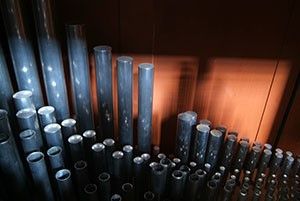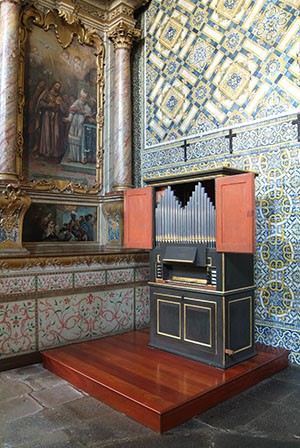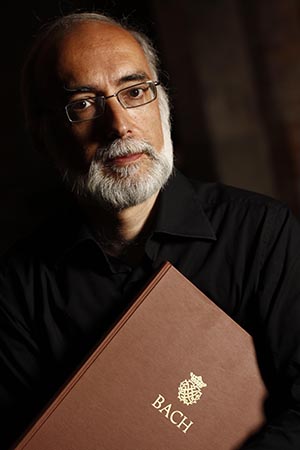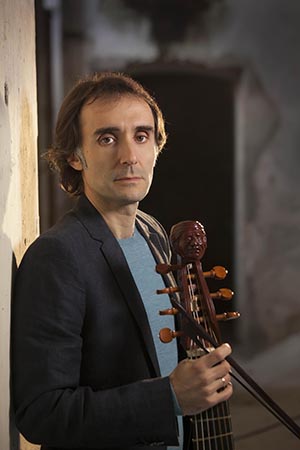 Sunday, 18 October, 6.00, p.m.
Sunday, 18 October, 6.00, p.m.
Church and Convent of Santa Clara
Lorenzo Ghielmi (organ and harpsichord) and Vittorio Ghielmi (viola da gamba)
Domenico Zipoli (1688-1726)
Sonata in D minor (on material originally composed by Arcangelo Corelli)
Preludio
Allegro
Adagio
Allegro
Bernardo Pasquini (1637-1710)
Variazioni per il paggio tedesco
Toccata con lo scherzo del cucco
Passacagli per lo scozzese
Domenico Scarlatti (1685-1757)
Sonata em ré menor K 92
Lorenzo Ghielmi, órgão
Karl Friedrich Abel (1723-1787)
Two pieces from the notebook of improvisations (Drexel Collection, Nova Iorque/New York)
Allegro moderato
Allegro
Sonata in E minor for viola da gamba and basso continuo
Siciliano
Allegro
Presto
Marin Marais (1656-1728)
Prélude
Rondeau le bijou
Antoine Forqueray (1671-1745)
Le Carillon de Passy
La Leclair
Chaconne, la Buisson
In Italy, instrumental music was at its most splendid during the baroque. Many virtuosos were called to the most important European courts and, from every country, young musicians anxious to improve their skills hurried to Venice, Naples and Rome. Bernardo Pasquini, born in Tuscany, spent his life in Rome, where he attracted numerous pupils, including Georg Muffat and Francesco Gasparini. His music is greatly influenced by Arcangelo Corelli, whose harpsichord accompanist he became. On a journey to Paris, he had occasion to perform before the Sun King at the court of Versailles and, like most Italian composers, wrote many theatrical works. Today he is known for his works for harpsichord and organ, which have come down to us thanks to two precious autograph collections. Domenico Zipoli, of Tuscan origin, also completed his studies in Rome. Leaving for South America with the Company of Jesus, he made use of music in the Jesuit missions in order to evangelize the local populations. The organ method attributed to him was found in an archive in Bolivia and contains many adaptations for organ of violin sonatas by Corelli. Domenico Scarlatti, the greatest harpsichordist of the Neapolitan school, came to reside in the Iberian Peninsula, his sonatas were composed at the Court in Madrid. Many of them, almost always intended for harpsichord, work equally well when played on the organ. It is known that, at the Madrid Court, in addition to a harpsichord with three keyboards, there were fortepianos and a chamber organ.
The viola da gamba, an instrument widely played during the renaissance, reached its apogee during the French baroque. At the Court of Versailles, the viola da gamba was the preferred instrument, and a series of virtuosos published in Paris a number of collections of compositions expressly written for the viol. From amongst these musicians the names of Marin Marais and Antoine Forqueray standout, known by their contemporaries as “the angel and the devil”. Their contrasting characters – one gentle and refined, the other irascible and impetuous – are reflected well in their music. In their compositions, the viola da gamba reaches the highest point of its technical and expressive possibilities. Karl Friedrich Abel is considered the last musician to have composed for the viola da gamba, an instrument that during the romantic period was replaced by the simpler and more popular 'cello. Abel's style, born in the shadow of Bach, was much influenced by the Berlin school: amongst the musicians who dominated the musical scene there stood out the Graun brothers and Carl Philipp Emanuel Bach. Abel became a friend of Johann Christian Bach, the youngest son of the Cantor of Leipzig, with whom he moved to England and with whom he gave many concerts. Abel's music already shows the beginnings of the classical school: during his long life he was able to hear music by Mozart and the young Haydn, and in his works for solo viol, almost written-out improvisations, the baroque, galant and classical idioms mix freely together.
Lorenzo Ghielmi
Participants
|
Lorenzo Ghielmi spent many years of his career studying the performance of renaissance and baroque music. He performs throughout Europe, Japan and the United States, and his concerts are frequently recorded for radio. His recordings of Bruhns, Bach and the concertos of Handel and Haydn for organ and orchestra were awarded the “Diapason d'Or”. He has published a book on Nicolaus Bruhns and studies on organs the performance of the music of Bach. He teaches organ, harpsichord and chamber music at the Municipal School os Music in Milan. Since 2006 he has been professor of organ at the Schola Cantorum Basiliensis, in Basle. He is organist of the Ahrend organ of the Basilica of San Simpliciano in Milan. In 2005 he has founded his ensemble La Divina Armonia, with which he realised several recordings. He is a member of the jury for various international organ competitions, such as Toulouse, Chartres, Tokyo, Bruges, Freiberg, Maastricht, Lausanne, Nuremberg, Graz and St Albans. |
|
An Italian performer (on the viola da gamba), conductor and composer, compared by critics to Jascha Heifetz (“Diapason”) for his virtuosity and described as an “alchemist of sound” (“Diário de Sevilla”) for the intensity of his musical performance. Born in Milan, he studied with R. Gini, W. Kuijken (Brussels) and C. Coin (Paris). He receivedm in 1997, the Erwin Bodky Award (Cambridge, USA). In 1995, he won the R. Romanini International Competition (Brescia). As a soloist and conductor he has appeared in most of the best-known concert halls throughout the world, accompanied by the great orchestras (Los Angeles {Philharmonic Orchestra at the Hollywood Bowl, London Philharmonic, Il Giardino Armonico, the Freiburg Baroque Orchestra, etc.) and in solo recitals. He has given world premieres of new works (including Concerto for Viola and Orchestra by Uri Caine, Concertgebouw Amsterdam and Brussels Bozarm 2008). from 2007 to 2010 he participated with Riccardo Muti in the Salzburg Festival. In 2007, he devised and directed a theatrical show based on Buxtehude's cycle Membra Jesu nostri, with the video and cinema director Marc Reshovsky (Hollywood) and the Rilke Ensemble (G. Eriksson, Switzerland). In 2010 he was resident artist at the Musikfest Stuttgart, and in 2011 at the Brussels Bozar festival and the Festival of Segovia. He is professor of viola da gamba at the Mozarteum in Salzburg. The ensemble he founded, Il Suonar Parlante, has concieved and developed new projects with jazz musicians such as Kenny Wheeler, Uri Caine, Markus Stockhausen, Ernst Rejiseger, the flamenco star Carmen Linares, and traditional music from oustide music (Ensemble Kaboul). His collaboration with different folk musicians has been documented in the film "The Heart of Sound" by BFMI (Salzburg- Hollywood). |
Notes about the Organ
 Church and Convent of Santa Clara, Funchal
Church and Convent of Santa Clara, Funchal
The church of Santa Clara had acquired a small positive organ with Italo-Iberian characteristics in the 18th century. With the extinction of the religious orders and the subsequent sale of the congregation’s goods, the organ was also put up for sale, being purchased by a certain Romano de Santa Clara, who kept it in a wing of the dissolved convent. In 1921 he gave it to the fraternity of Santa Clara, so that it could once more be put to service in the worship of the church. In October 1923 the task of ‘repairing’ it was put in the hands of the musicians César R. Nascimento and Guilherme H. Lino, who completed the work in November of the following year.
Unused and badly damaged for many years, this instrument of considerable historical value underwent a major restoration by Dinarte Machado on the basis of proper criteria drawn from a knowledge of the organ-building practices of the instrument’s period. This was completed in 2001. The poor state of the instrument, completely disfigured, required a rigorous, in-depth study on which to base this restoration. Thus we see how from the outset Dinarte Machado went to considerable pains in the course of this restoration.
Manual (C, D, E, F, G, A, Bb-c’’’)
Principale (c#’-c’’’)
Ottava (4’)
Quintadecima (2´)
Decimanona (1 1/3´)
Vigesimaseconda e Trigesimasesta
Flauto 8’
Flauto 4’
 Lorenzo Ghielmi
Lorenzo Ghielmi